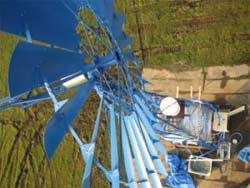A traditional windmill which drives a pump: that is the simple concept behind the combination of windmill/reverse osmosis developed by the Delft University of Technology (TU Delft) in The Netherlands. In this case, it involves a high-pressure pump which pushes water through a membrane using approximately 60 bar. This reverse osmosis membrane produces fresh water from seawater directly.
The windmill is suited for use by, for instance, small villages in isolated, dry coastal areas.
The combination of windmills and desalination installations is already commercially available. These windmills produce electricity from wind power, the electricity is stored and subsequently used to drive the high-pressure pump for the reverse osmosis installation. The storage of electricity in particular is very expensive. Energy is also lost during conversion.
In the TU Delft installation, the high-pressure pump is driven directly by wind power. Water storage can be used to overcome calm periods. The storage of water is after all a great deal cheaper than that of electricity.
The chosen windmill is normally used for irrigation purposes. These windmills turn relatively slowly and are also very robust. On the basis of the windmill’s capacity at varying wind speeds, it is estimated that it will produce 5 to 10 m3 of fresh water per day: enough drinking water for a small village of 500 inhabitants. A water reservoir will have to ensure that enough water is available for a calm period lasting up to five days.
Three safeguards (in the event of the installation running dry, a low number of revolutions or a high number of revolutions) are also performed mechanically so that no electricity is needed.

